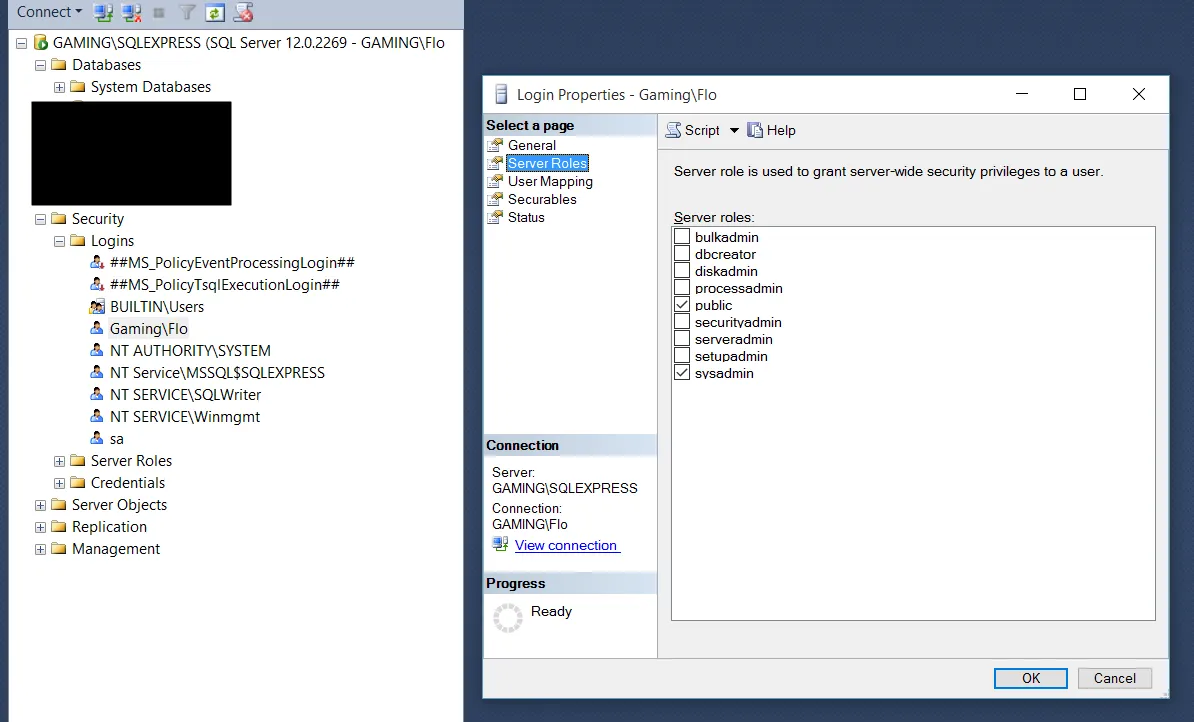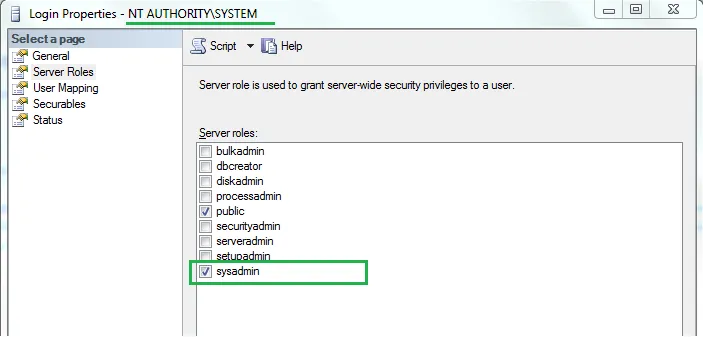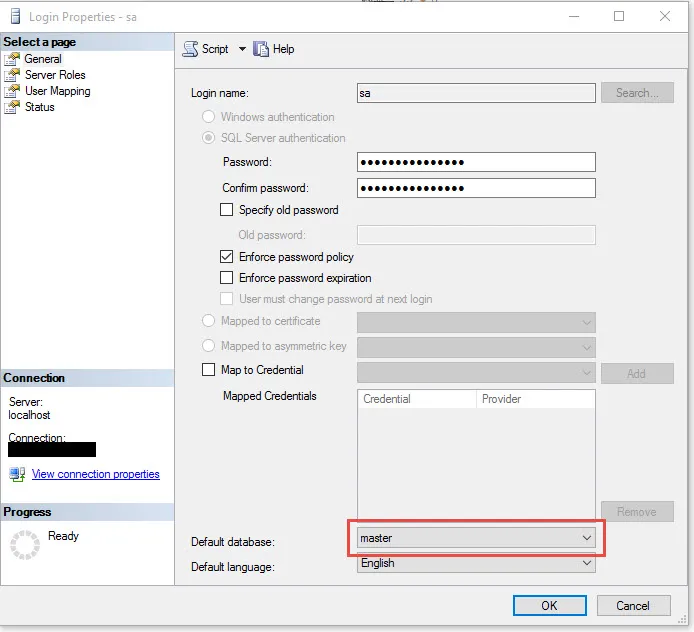首先,我已经在这里检查过了:ASP.Net Identity如何设置目标数据库?
现在我遇到了这个错误。
CREATE DATABASE权限在数据库'master'中被拒绝。
出错的代码行如下:
Dim user As User = manager.Find(Trim(Username.Text), Trim(Password.Text))
完整错误:
[SqlException (0x80131904): CREATE DATABASE permission denied in database 'master'. System.Data.SqlClient.SqlConnection.OnError(SqlException exception, Boolean breakConnection, Action1 wrapCloseInAction) +3249852 System.Data.SqlClient.TdsParser.ThrowExceptionAndWarning(TdsParserStateObject stateObj, Boolean callerHasConnectionLock, Boolean asyncClose) +345 System.Data.SqlClient.TdsParser.TryRun(RunBehavior runBehavior, SqlCommand cmdHandler, SqlDataReader dataStream, BulkCopySimpleResultSet bulkCopyHandler, TdsParserStateObject stateObj, Boolean& dataReady) +4927 System.Data.SqlClient.SqlCommand.RunExecuteNonQueryTds(String methodName, Boolean async, Int32 timeout, Boolean asyncWrite) +1287 System.Data.SqlClient.SqlCommand.InternalExecuteNonQuery(TaskCompletionSource`1 completion, String methodName, Boolean sendToPipe, Int32 timeout, Boolean asyncWrite) +367 System.Data.SqlClient.SqlCommand.ExecuteNonQuery() +386 System.Data.Entity.Infrastructure.Interception.InternalDispatcher`1.Dispatch(TTarget target, Func`3 operation, TInterceptionContext interceptionContext, Action`3 executing, Action`3 executed) +965 System.Data.Entity.Infrastructure.Interception.DbCommandDispatcher.NonQuery(DbCommand command, DbCommandInterceptionContext interceptionContext) +505 System.Data.Entity.SqlServer.<>c__DisplayClass1a.b__19(DbConnection conn) +136 System.Data.Entity.SqlServer.SqlProviderServices.UsingConnection(DbConnection sqlConnection, Action`1 act) +347 System.Data.Entity.SqlServer.SqlProviderServices.UsingMasterConnection(DbConnection sqlConnection, Action`1 act) +916 System.Data.Entity.SqlServer.SqlProviderServices.CreateDatabaseFromScript(Nullable`1 commandTimeout, DbConnection sqlConnection, String createDatabaseScript) +117 System.Data.Entity.SqlServer.SqlProviderServices.DbCreateDatabase(DbConnection connection, Nullable`1 commandTimeout, StoreItemCollection storeItemCollection) +212 System.Data.Entity.Migrations.Utilities.DatabaseCreator.Create(DbConnection connection) +172 System.Data.Entity.Migrations.DbMigrator.EnsureDatabaseExists(Action mustSucceedToKeepDatabase) +175 System.Data.Entity.Migrations.DbMigrator.Update(String targetMigration) +116 System.Data.Entity.Internal.DatabaseCreator.CreateDatabase(InternalContext internalContext, Func`3 createMigrator, ObjectContext objectContext) +121 System.Data.Entity.Database.Create(DatabaseExistenceState existenceState) +169 System.Data.Entity.CreateDatabaseIfNotExists`1.InitializeDatabase(TContext context) +257 System.Data.Entity.Internal.InternalContext.PerformInitializationAction(Action action) +72 System.Data.Entity.Internal.InternalContext.PerformDatabaseInitialization() +483 System.Data.Entity.Internal.RetryAction`1.PerformAction(TInput input) +177 System.Data.Entity.Internal.LazyInternalContext.InitializeDatabaseAction(Action`1 action) +274 System.Data.Entity.Internal.InternalContext.GetEntitySetAndBaseTypeForType(Type entityType) +37 System.Data.Entity.Internal.Linq.InternalSet`1.Initialize() +76 System.Data.Entity.Internal.Linq.InternalSet`1.get_InternalContext() +21 System.Data.Entity.Infrastructure.DbQuery`1.System.Linq.IQueryable.get_Provider() +59 System.Data.Entity.QueryableExtensions.FirstOrDefaultAsync(IQueryable`1 source, Expression`1 predicate, CancellationToken cancellationToken) +208 System.Data.Entity.QueryableExtensions.FirstOrDefaultAsync(IQueryable`1 source, Expression`1 predicate) +172 Microsoft.AspNet.Identity.EntityFramework.d__6c.MoveNext() +502 System.Runtime.CompilerServices.TaskAwaiter.ThrowForNonSuccess(Task task) +13855856 System.Runtime.CompilerServices.TaskAwaiter.HandleNonSuccessAndDebuggerNotification(Task task) +61 Microsoft.AspNet.Identity.CultureAwaiter`1.GetResult() +48 Microsoft.AspNet.Identity.d__12.MoveNext() +357 System.Runtime.CompilerServices.TaskAwaiter.ThrowForNonSuccess(Task task) +13855856 System.Runtime.CompilerServices.TaskAwaiter.HandleNonSuccessAndDebuggerNotification(Task task) +61 Microsoft.AspNet.Identity.AsyncHelper.RunSync(Func`1 func) +348 MyApp.Login_identity.UserLogin_Click(Object sender, EventArgs e) in C:\MyApp\Login_identity.aspx.vb:168 System.Web.UI.WebControls.Button.OnClick(EventArgs e) +11747645 System.Web.UI.WebControls.Button.RaisePostBackEvent(String eventArgument) +150 System.Web.UI.Page.ProcessRequestMain(Boolean includeStagesBeforeAsyncPoint, Boolean includeStagesAfterAsyncPoint) +3360]我将AppModel.vb中的DbContext初始化更改为现有的连接字符串conn1,该连接字符串指向我已经转换为新标识表的SQL Server数据库。我的连接字符串:
<add name="conn1"
connectionString="data source=(local)\sqlexpress;Initial Catalog=myapp;User Id=sa;Password=XXXX;"
providerName="System.Data.SqlClient" />
AppModel.vb:
Imports Microsoft.AspNet.Identity
Imports Microsoft.AspNet.Identity.EntityFramework
Imports System.Collections.Generic
Imports System.ComponentModel.DataAnnotations
Imports System.Data.Entity
Imports System.Linq
Imports System.Web
Namespace AspnetIdentitySample.Models
Public Class ApplicationUser
Inherits IdentityUser
' HomeTown will be stored in the same table as Users
Public Property HomeTown() As String
Get
Return m_HomeTown
End Get
Set(value As String)
m_HomeTown = Value
End Set
End Property
Private m_HomeTown As String
Public Overridable Property ToDoes() As ICollection(Of ToDo)
Get
Return m_ToDoes
End Get
Set(value As ICollection(Of ToDo))
m_ToDoes = Value
End Set
End Property
Private m_ToDoes As ICollection(Of ToDo)
' FirstName & LastName will be stored in a different table called MyUserInfo
Public Overridable Property MyUserInfo() As MyUserInfo
Get
Return m_MyUserInfo
End Get
Set(value As MyUserInfo)
m_MyUserInfo = Value
End Set
End Property
Private m_MyUserInfo As MyUserInfo
End Class
Public Class MyUserInfo
Public Property Id() As Integer
Get
Return m_Id
End Get
Set(value As Integer)
m_Id = Value
End Set
End Property
Private m_Id As Integer
Public Property FirstName() As String
Get
Return m_FirstName
End Get
Set(value As String)
m_FirstName = Value
End Set
End Property
Private m_FirstName As String
Public Property LastName() As String
Get
Return m_LastName
End Get
Set(value As String)
m_LastName = Value
End Set
End Property
Private m_LastName As String
End Class
Public Class ToDo
Public Property Id() As Integer
Get
Return m_Id
End Get
Set(value As Integer)
m_Id = Value
End Set
End Property
Private m_Id As Integer
Public Property Description() As String
Get
Return m_Description
End Get
Set(value As String)
m_Description = Value
End Set
End Property
Private m_Description As String
Public Property IsDone() As Boolean
Get
Return m_IsDone
End Get
Set(value As Boolean)
m_IsDone = Value
End Set
End Property
Private m_IsDone As Boolean
Public Overridable Property User() As ApplicationUser
Get
Return m_User
End Get
Set(value As ApplicationUser)
m_User = Value
End Set
End Property
Private m_User As ApplicationUser
End Class
Public Class MyDbContext
Inherits IdentityDbContext(Of ApplicationUser)
Public Sub New()
MyBase.New("conn1") 'DefaultConnection
End Sub
Protected Overrides Sub OnModelCreating(modelBuilder As DbModelBuilder)
MyBase.OnModelCreating(modelBuilder)
' Change the name of the table to be Users instead of AspNetUsers
modelBuilder.Entity(Of IdentityUser)().ToTable("Users")
modelBuilder.Entity(Of ApplicationUser)().ToTable("Users")
End Sub
Public Property ToDoes() As DbSet(Of ToDo)
Get
Return m_ToDoes
End Get
Set(value As DbSet(Of ToDo))
m_ToDoes = Value
End Set
End Property
Private m_ToDoes As DbSet(Of ToDo)
Public Property MyUserInfo() As DbSet(Of MyUserInfo)
Get
Return m_MyUserInfo
End Get
Set(value As DbSet(Of MyUserInfo))
m_MyUserInfo = Value
End Set
End Property
Private m_MyUserInfo As DbSet(Of MyUserInfo)
End Class
End Namespace
更新
根据一条评论,我也在这里进行了检查。
我真的不明白为什么这是一个角色问题,因为我正在重用一个连接字符串,该连接字符串已经可以正常更新其他(与标识相关的非)表。此外,我不明白为什么错误涉及到master表,因为我希望我没有通过manager.Find方法以任何方式尝试连接到它。
无论如何,我当前测试的用户已经被分配到sysadmin角色:
更新2
好的,感谢Jeremy在下面的评论,我又近了一步...我需要将用户IIS APPPOOL\.NET v4.5添加到sysadmin角色中,因为这是SQL Server Profiler中显示的连接用户(虽然我不确定添加此用户到此角色时的安全风险)。无论如何,Find方法不再抛出错误,并且当我执行此代码Dim user As User = manager.FindByName(Trim(Username.Text))时,使用SQL Server Profiler可以看到SQL语句已经被触发。
exec sp_executesql N'SELECT TOP (1)
[Extent1].[Id] AS [Id],
[Extent1].[ApplicationId] AS [ApplicationId],
[Extent1].[MobileAlias] AS [MobileAlias],
[Extent1].[IsAnonymous] AS [IsAnonymous],
[Extent1].[LastActivityDate] AS [LastActivityDate],
[Extent1].[MobilePIN] AS [MobilePIN],
[Extent1].[LoweredEmail] AS [LoweredEmail],
[Extent1].[LoweredUserName] AS [LoweredUserName],
[Extent1].[PasswordQuestion] AS [PasswordQuestion],
[Extent1].[PasswordAnswer] AS [PasswordAnswer],
[Extent1].[IsApproved] AS [IsApproved],
[Extent1].[IsLockedOut] AS [IsLockedOut],
[Extent1].[CreateDate] AS [CreateDate],
[Extent1].[LastLoginDate] AS [LastLoginDate],
[Extent1].[LastPasswordChangedDate] AS [LastPasswordChangedDate],
[Extent1].[LastLockoutDate] AS [LastLockoutDate],
[Extent1].[FailedPasswordAttemptCount] AS [FailedPasswordAttemptCount],
[Extent1].[FailedPasswordAttemptWindowStart] AS [FailedPasswordAttemptWindowStart],
[Extent1].[FailedPasswordAnswerAttemptCount] AS [FailedPasswordAnswerAttemptCount],
[Extent1].[FailedPasswordAnswerAttemptWindowStart] AS [FailedPasswordAnswerAttemptWindowStart],
[Extent1].[Comment] AS [Comment],
[Extent1].[Email] AS [Email],
[Extent1].[EmailConfirmed] AS [EmailConfirmed],
[Extent1].[PasswordHash] AS [PasswordHash],
[Extent1].[SecurityStamp] AS [SecurityStamp],
[Extent1].[PhoneNumber] AS [PhoneNumber],
[Extent1].[PhoneNumberConfirmed] AS [PhoneNumberConfirmed],
[Extent1].[TwoFactorEnabled] AS [TwoFactorEnabled],
[Extent1].[LockoutEndDateUtc] AS [LockoutEndDateUtc],
[Extent1].[LockoutEnabled] AS [LockoutEnabled],
[Extent1].[AccessFailedCount] AS [AccessFailedCount],
[Extent1].[UserName] AS [UserName]
FROM [dbo].[AspNetUsers] AS [Extent1]
WHERE ((UPPER([Extent1].[UserName])) = (UPPER(@p__linq__0))) OR ((UPPER([Extent1].[UserName]) IS NULL) AND (UPPER(@p__linq__0) IS NULL))',N'@p__linq__0 nvarchar(4000)',@p__linq__0=N'flo@outlook.com'
奇怪的是:当我在SQL Server Management Studio中直接执行它时,会返回一条记录,但在我的代码中,变量user是Nothing。那是什么原因呢?



Public Sub New() MyBase.New("conn1") 'DefaultConnection End Sub- Adam